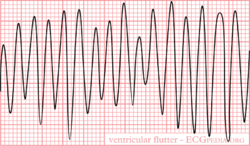Ventricular Flutter: Difference between revisions
Jump to navigation
Jump to search
m New page: {{Chapter|Ventricular Arrhythmias}} {{Arrhythmias| | name = Ventricular Flutter | locatieImage = | atrial_frequency = 60-100 bpm | ventricular_frequency = 150-300 bpm | regularity = regul... |
No edit summary |
||
| (One intermediate revision by one other user not shown) | |||
| Line 12: | Line 12: | ||
| example2 = | | example2 = | ||
}} | }} | ||
Ventricular Flutter is mostly caused by re-entry with a frequency of 300 bpm. The ECG shows a typical sinusoidal pattern. During ventricular flutter the ventricles depolarize in a circular pattern, which prevents good function. Most often this results in a minimal cardiac output and subsequent ischemia. Often deteriorates into [[ | [[Image:ventricular_flutter_12lead.jpg|thumb|A ventricular flutter on a 12 lead ECG]] | ||
Ventricular Flutter is mostly caused by re-entry with a frequency of 300 bpm. The ECG shows a typical sinusoidal pattern. During ventricular flutter the ventricles depolarize in a circular pattern, which prevents good function. Most often this results in a minimal cardiac output and subsequent ischemia. Often deteriorates into [[Ventricular Fibrillation]].{{clr}} | |||
Latest revision as of 15:41, 2 February 2008
| This is part of: Ventricular Arrhythmias |

Ventricular Flutter is mostly caused by re-entry with a frequency of 300 bpm. The ECG shows a typical sinusoidal pattern. During ventricular flutter the ventricles depolarize in a circular pattern, which prevents good function. Most often this results in a minimal cardiac output and subsequent ischemia. Often deteriorates into Ventricular Fibrillation.
